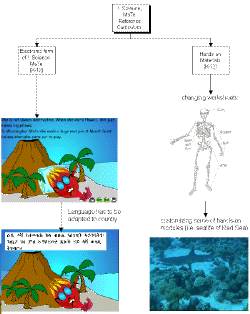
Curriculum in developing countries can help achieve a country’s national priorities by providing skills to its people. The Eritrean government is looking toward science and technology to help provide a way for citizens to communicate and work on common goals. The new national curriculum developed under this project will engage children in a practical and applied understanding of science that can assist their country’s development.
Click on picture to enlarge
Developing an entire new national curriculum is costly and time consuming. The use of the I. Science MaTe as a template to customize for use in Eritrea saves enormous time and expense. Teachers, curriculum writers, and the national coordinator will determine which units from the I.Science MaTe are appropriate for teaching in Eritrea. In the first year a partial curriculum program will be introduced at the pilot schools. The Math/Science Nucleus will guide and consult on the implementation. The scope and sequence of the curriculum will be revised to the meet the needs of the country. As the customization progresses in subsequent years, more of the I. Science MaTe will be customized and introduced into the curriculum. The completion and customization of material will done as the project proceeds, so new units can be tested and changed easily before the replication phase of the project ends. By the end of the third year, a complete national curriculum drawn from the I. Science Mate will have evolved.
The electronic form of the curriculum provides teachers with all the background information and methodology they need to teach math and science to children and young adults. Instead of teachers needing many books to learn the curriculum, they will have the entire curriculum resident on a web appliance from which they can learn the material interactively. The same web appliance can be used for teacher education classes at the teacher training institutes and the university.
Portions of the curriculum are browser based and allow easy integration of video, sound, and graphics. Other portions of the curriculum are in the form of electronic textbook which present textual information electronically.
Both portions of the primary school curriculum will be reformatted to accommodate the 9 Eritrean ethnic groups. The hands-on materials will be localized to be most effective. Figure 4 shows an example of one frame from the animated module on volcanoes in which the language has been modified and the hands-on modules for sea life is specified to include seashells drawn from the Red Sea that borders Eritrea in the east. An electronic version of this can be viewed by looking at our website (http://msnucleus.org).
Coordination with Higher Education
Any curriculum reform needs to include higher education in order to maintain the change, as higher education is where philosophy of teaching methods is taught. In Eritrea, the institutional pattern of higher education is still being formed and evaluated. After the 30-year war, there was no higher education in Eritrea. The University of Asmara was re-established in 1991 and has grown in size and class offerings. University of Asmara is presently responsible for the preparation of secondary school teachers through the newly formed Department of Education.
The Teacher Training Institutes prepare the country’s primary school teachers through a one-year training course. Math/Science Nucleus has its office located at the Asmara Teacher Training Institute which trains most of the primary school teachers.
Math/Science Nucleus will work to make sure there is an integrated effort in teacher training at both institutions. When the scope of the project extends to secondary school curriculum, the University of Asmara will be more directly involved.